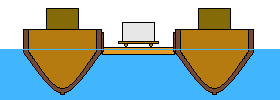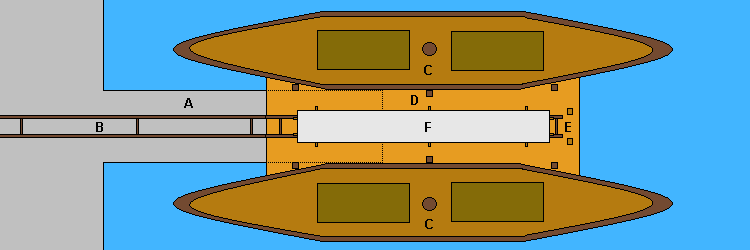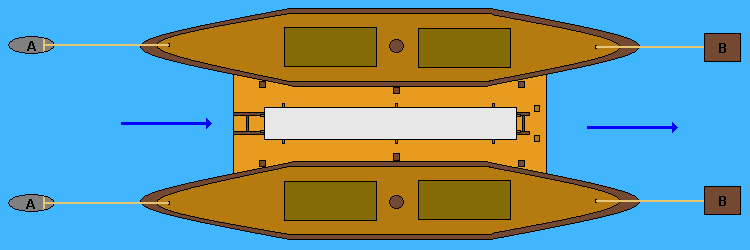How were the pyramids built?
Transporting stone blocks down the Nile
A new method by Franz Löhner
How were the Tura stones and granite blocks transported down the Nile?
The Nile and the Nile channels - Transporting
stones on the Nile - Heavy loads on special barges
- The harbor facilities at the quarries in Aswan
- Steering the barges - Unloading
in the harbor of Giza
A simple solution / method? - Historical sources - Questioning this method - Sources
 The Nile and the Nile channels
The Nile and the Nile channels
Along the Nile lie several quarries where different types of stones were quarried and brought to the building sites by boat. Granite stones from Aswan had to be ferried down the river on large barges about 934 km (approx. 700km linear distance). Ships transporting limestone from Tura had to cross the Nile and then cover about 13-17km on channels until they reached the harbor of Giza (see map).
Practically the whole year there is a strong north-south wind on the Nile, so the barges couldn't sail when going from Aswan to Giza, but only on their way back. Instead the barges used the river currents to drift down. In the lower part of the Nile, close to Giza, they probably used the Bahr Yussuf-channel (Bahr Jusuf or Josefs-channel) or a branch of that channel. On these channels the barge had to be towed by men.

Tomb of Qar at Giza (6th dynasty): Men towing the funerary boat of Qar
 Transporting stones on the Nile
Transporting stones on the Nile
With heavy stones like the granite beams for the Kings' chamber of Khufu's pyramid, you have to consider, that if you load or unload them from barges, those barges are very likely to tilt and capsize. There are no good explanations, how this was done, except if you use hoists or cranes. Since those were not known at the time when the pyramids were built, there has to be another solution.
Franz Löhner has thought about a few details how the large and heavy stone blocks could have been loaded on the boats and transported down the Nile, for example from Aswan to Giza.
| 1. | New | Two barges and a raft on which the stone lies are combined. The raft is tied to the longitudinal side of each barge, so the barges don't tilt towards the inner side. The raft and the two barges have enough buoyancy to counterbalance the weight of the stone (doctrine = one barge) |
| 2. | New | In the harbor loading ramps are built sloping from the land into the river. The raft is lying in the middle and on top of the ramp and the two barges on both sides of the ramp. The stones are tied to sledges and then hauled over the ramp onto the raft. Two rope rolls are used, installed on the raft. (doctrine = unexplained) |
| 3. | The Tura stones and the granite blocks are brought to giza on the Nile with ships (= doctrine) | |
| 4. | A small raft is drifting in front of the boat and in the back of the boat a round stone attached to a rope is towed over the river bed. The steering is done with the ropes attached at the back. This is a so called Herodotus' steering (According to Goyon [3]) | |
| 5. | New | In the harbor of Giza ramps for unloading are built from stones or wood, sloping from the land into the river. The sledges are hauled over the tracks on land. To accomplish this, rope rolls are installed on land. (doctrine = unexplained) |
 Transporting heavy loads on the Nile with special barges
Transporting heavy loads on the Nile with special barges

According to G. Goyon [3] the Egyptian barges (or ships) can carry an average load of 40 tons. For his calculations Franz Löhner reduces this figure to 30-35 tons. With the combination of two barges and the rigidly attached raft the load-carrying capacity of the ships adds to 60 to 70 tons. In addition there is the raft which is constructed from at least two large layers of logs on top of each other (one layer lengthwise, one across) and which had a load-carrying capacity of about 10 to 15 tons. Together this adds to 80-90 tons load capacity. The stones weighting up to 50 tons can be carried with no problems downstream on such barges . This double ferry (we call it a ferry because it is carrying or ferrying the sledges with freight) can also be used for the shorter distance from the Tura quarry to Giza. Ferries like this were used in Europe on rivers and lakes during the last century to transport heavy loads.
 The harbor facilities at the quarries in Aswan
The harbor facilities at the quarries in Aswan
The main problem with ships is how to load the heavy stones on top without the ships tilting to one side. Here the advantages of this kind of combination of a raft and two barges are obvious, because the stone can be hauled onto the raft on a simple loading ramp which slopes into the river.
In the granite quarries of Aswan the large stones, weighting up to 50
tons are split from the rock beds and topples on a soft bed of sand. Now
it is attached to a sledge and hauled to the work shop where the final
touches are made. Now it is already exactly the size and shape which the
pyramid engineers ordered. Afterwards it is brought to the harbor with
the help of rope rolls and a track system similar to the one used from
the harbor in Giza up to the foot of the pyramid.
![]() Cutting granite with iron tools
Cutting granite with iron tools
![]() Transporting the stone blocks using a sledge
on tracks
Transporting the stone blocks using a sledge
on tracks
A massive landing ramp (like a pier) is built at the shore of the Nile, where the two barges with the raft between are waiting. This landing ramp is sloping into the river, so the lower part is covered by water even if the river runs low. The ferry is berthed on the ramp in such a way, that the raft in the middle is lying on top of the ramp and the two barges (which have more draft) on both sides of the ramp.
Illustration: A raft (D) is tied to the longitudinal side of the two barges (C). Sloping loading ramp (A) with tracks (B) leading underneath the raft with the granite beam (F). Two rope rolls (E) are installed on the raft.
This kind of landing ramp and the way the barges are berthed has a lot of advantages, mainly, that the track system (B = round logs with joined by cross-pieces to form tracks) can be laid down all the way down the landing ramp (A), and joining the tracks which are also installed on the raft (D). On the side of the raft facing away from the shore two rope rolls (E) are installed permanently on the raft. With their help the sledge with the granite block (F) strapped to it can be hauled onto the raft. These rope rolls enormously facilitate the loading.
With this method the barges mainly serve to stabilize and to give more buoyancy. Another advantage is, that it is not necessary to hoist the heavy stones onto the ships. No Egyptologist has yet explained how you can accomplish that without the ships overbalancing and capsizing!
 Steering the barges
Steering the barges
After casting off, in front of the bow of each ship a small raft (B) is tied to a rope so it floats in front of the barges and at the stern (back) a round longish stone (A) tied to a rope is let into the water. This stone is hauled lightly over the ground of the river and the two floats in front keep the combination of barges and raft steadily in the current. The two barges and the raft would be difficult to control, but by shortening and lengthening the ropes or even haul the weights on board, this ferry can be steered better than with a rudder. The stone is rounded, so it doesn't get ensnarled in anything on the ground of the river. (Herodotus' steering, tested and found effective by the Laboratoire Central d'Hydraulique de France - Herodotus' text - but the small float behind the boat suggested by G. Goyon [3] is not necessary).
Illustration: Small raft (B) in front of the barges and a stone (A) tied to a rope in the back.
If we assume, that this ferry can cover an average distance of 3 km hourly during twelve hours per day, to cover the distance of over 900 km from the quarries of Aswan downriver to the plateau of Giza it would need about 25 days. Of course at night they berthed somewhere at the shore of the Nile.
 Unloading in the harbor of Giza
Unloading in the harbor of Giza
Having arrived at the Giza plateau after a journey of over 900 kilometers, the stones were unloaded and then rope rolls and sledges on tracks were used for transporting the heavy loads up to the pyramid.
Unloading the heavy granite stones (and any other stones) was again facilitated by a landing ramp sloping into the water. The raft in the middle of the two barges was maneuvereduntil it lay flush on the lower part of the ramp. Because the ramp was sloping this could be accomplished even if the water level was low. A track system made from round logs was installed on the landing ramp, so the sledges with the stones tied to them could easily be hauled down from the raft and onto the pier and from there up to the pyramid. At the same harbor over 70 stones (of 1.5 to 5 tons) used for the outer casing were unloaded daily from the Tura quarries.
For the granite blocks a separate route which goes from the harbor to
the foot of the pyramid is installed with heavy tracks and rope roll stations
about every 75 meters. The weight of the huge stone blocks is distributed
among more rope rolls and of course for these large weights you need more
haulers per team (using rope rolls a 40 tons block needs 320
haulers on a slope of 5°). It is also possible, that instead of two
hauling teams per section there were four teams with ropes of different
lengths, so they could walk one team behind the other. The granite beams
are hauled up lengthwise to produce less friction.
![]() Transporting the large granite blocks
up the pyramid
Transporting the large granite blocks
up the pyramid
![]() Calculating the force and kinetic coefficient
of friction necessary
Calculating the force and kinetic coefficient
of friction necessary
 Five requirements that every pyramid construction theory should fulfill
Five requirements that every pyramid construction theory should fulfill
Franz Löhner stipulates that any method or theory for pyramid construction should fulfill the following 5 requirements, otherwise it should be rejected:
1. A solution that is as simple as possible using a technology that is
as simple as possible (Occam's razor)
2. Continuity in technical matters and craftsmanship
3. Verification through pictures and/or text
4. Technology keeping with the time and culture
5. The supposed technique / method must really be a solution
 A simple solution / method?
A simple solution / method?
Does the solution proposed on this page by Franz Löhner also meet those five requirements?
| About the 1st requirement (simple solution):
Franz Löhner's methods don't ask for time-consuming or complicated techniques, but what he proposes are by all means techniques, that the ancient Egyptians knew and had mastered! |
 What was found? The historical sources
What was found? The historical sources
| About the 2nd requirement (technical continuity):
The solar barque found near the pyramid of Khufu proves, that the ancient Egyptians knew very well how to build ships. The solar barque had about 45 tonnage displacement, two similar ships and a raft would therefore easily have enough water displacement to transport a stone weighting 50 tons. |
This kind of combined barge and raft is also known from ferries in Europe which were used until not long ago. Franz Löhner has seen a ferry like this on the Boiana where 6 cars filled with tourists or buses and trucks were transported across the river. This ferry was used by thousands of travelers. In 1957/58 while working in Holland he crossed the Water Waal (Rhine) daily with a ferry consisting of two boats and a wooden raft. This ferry was running several times a day from Thiel to Dreumel and crossed a distance of about a kilometer. It also worked for very heavy loads like trucks or cars.
| About the 3d requirement (verification through pictures and/or text): |
Herodotus' steering:
Herodotus was a Greek historian who lived about 2000 years later
and wrote about how the stones were transported from the quarries: "These
boats cannot sail up the river unless there be a very fresh wind blowing,
but are towed from the shore: down-stream however they travel as follows:
they have a door-shaped crate made of tamarisk wood and reed mats sewn
together, and also a stone of about two talents weight bored with a hole;
and of these the boatman lets the crate float on in front of the boat,
fastened with a rope, and the stone drag behind by another rope. The crate
then, as the force of the stream presses upon it, goes on swiftly and
draws on the "baris" (for so these boats are called), while
the stone dragging after it behind and sunk deep in the water keeps its
course straight. These boats they have in great numbers and some of them
carry many thousands of talents' burden." (Herodotus,
The Histories second Book, Number 96)
Capacity of transporting:
There are chronicles on papyrus [2],
where ships are listed, which transported sandstone blocks from the quarries
of Gebel Silsila to the Ramesseum. Calculations [1]
show, that five to seven stone blocks (of 1 to 5 tons) resulting in a
total of 15 to 20 tons were loaded on each ship and that daily
about 64 stone blocks arrived from the quarries.
When Franz Löhner calculates that 69 stones arrived daily in Giza
by ship from the quarries in Tura this is actually very realistic.
![]() Detailed calculations how many workers
were necessary to build the pyramid
Detailed calculations how many workers
were necessary to build the pyramid
![]() Quarrying stones for the pyramid
Quarrying stones for the pyramid

Transporting really large loads with ships on the Nile is
also documented. A well known engraving in the temple of queen Hatshepsut
shows the transport of two obelisks (each 323 tons [1])
on a barque from Aswan to Karnak (reconstruction from a partial relief
from Deir el-Bahari). The ship should actually lay much lower in the water
than shown. Another well known engraving is on a relief in the pyramid
complex of Unas in Saqqara, which shows how columns
were transported by ship.
![]() Transporting columns illustration
Transporting columns illustration
| About the 4th requirement (technology
keeping with the time and culture): With this and other paintings and carvings the use of ships, barges and rafts to transport stones is proved. |
 Questioning this technique / method
Questioning this technique / method
About the 5th requirement (is this
technique / method really a solution?): |
Question:
Which of the techniques described to transport stones on ships have you
tested?
F. Löhner's answer:
I haven't tested any of these techniques, but as written above
when I lived in Holland I have travelled many times on ferries which were
built like I described. Heavy cars and large lorries were also transported
with them across quite a large distance.
Question:
There are engravings and paintings of single ships with stones. Why use
two ships and a raft if you can do it with one?
F. Löhner's answer:
On these paintings smaller stones are transported. When the stones reach
a certain size the ship will start to tilt, then overbalance and capsize.
 Sources
Sources
These methods for building the pyramids were first published 1993 in the book "Der Bau der Cheops-Pyramide" by Heribert Illig and Franz Löhner.
[1] D. Arnold Building in Egypt
[2] W. Spiegelberg Hieratic
Ostraka and Pypyri Found by J.E. Quibell in the Ramesseum
[3] G. Goyon Die Cheops-Pyramide.
Geheimnis und Geschichte
| Copyright 2006: |
Franz Löhner www.cheops-pyramide.ch | |
| Concept and Design, English Texts: |
Teresa (Zubi) Zuberbühler www.starfish.ch |

